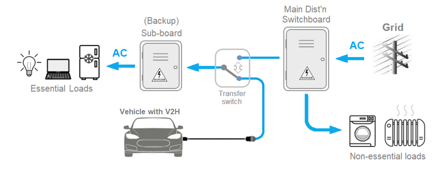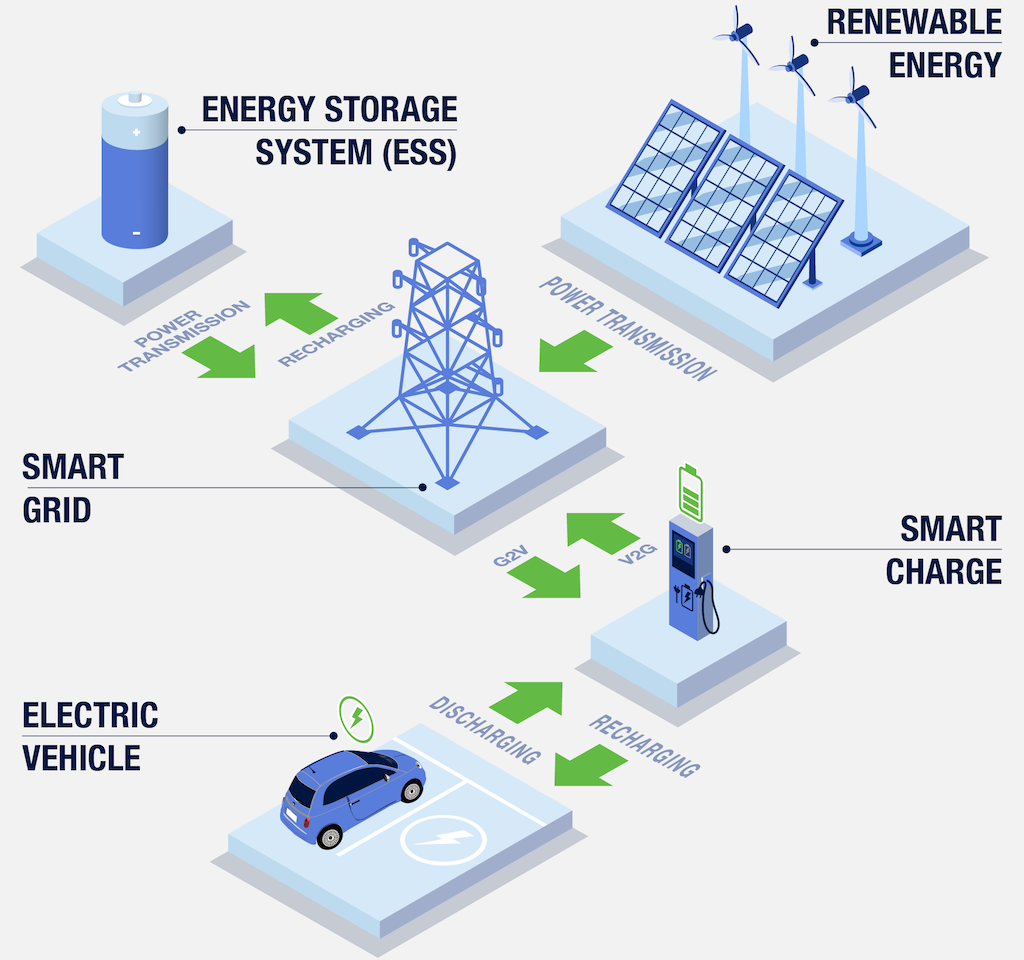Bidirectional charging technology might end up being one of the best perks of owning an EV. This technology allows you to use EV batteries for more than just driving. You can power appliances on the road, power your home, and earn paid incentives from power companies by delivering power to the grid.

What is Bidirectional Charging and How is it Different From Traditional EV Charging?
Before diving into bidirectional EV charging technology, you should first understand how AC charging works. Traditionally EV charging occurs in one way: AC power is delivered to the EV through the EV charger, the on-board EV charger then converts AC into DC power, and the battery gets charged. All batteries store power as DC power.
Bidirectional charging technology requires an EV with an on-board charger featuring bidirectional charging capability and a bidirectional capable EV charger. This technology charges your EV traditionally but can also convert stored DC power in the EV battery into AC to power appliances, your home, or send power to the grid for a reward.
It is unlikely that you will use bidirectional EV charging all day everyday, otherwise, you would be left with an empty battery in the morning. But, you could use bidirectional EV charging during blackouts or power outages. The best thing about it is that EVs have a much larger capacity than smart batteries for homes.
For instance, the Tesla Powerwall features a 13.5kWh storage capacity. An EV with a small battery of 40kWh equals having 3 Powerwalls, while an EV with a 90kWh battery is the same as having six or more Powerwalls at home.
Bidirectional Charging Applications
We will focus on Vehicle to Home (V2H) and Vehicle to Grid (V2G), but other applications include Vehicle to Load (V2L) and Vehicle to Building (V2B).
Vehicle to Home (V2H) charging
Vehicle to Home (V2H) is one of the most popular bidirectional EV charging applications. You can power your home that is connected to an emergency service panel or even power the entire home. V2H is one of your best solutions during scheduled blackouts and emergencies that leave you without power.
For safety precautions, V2H charging can only be used when the home is isolated from the grid, as if it were an off-grid home. In this scenario, your home will work like a micro-grid and your EV will be the power source of it. During V2H, your EV is responsible for generating the right voltage and frequency to power appliances across the home.
Vehicle to Grid (V2G) charging
Vehicle to grid charging or V2G is another great application of bidirectional technology. During V2G charging, the power grid can demand power from EVs to minimize power fluctuations, reduce stress on power generation during peak periods, and more. This makes the grid more flexible and resilient, granting it better stability.
Moreover, if your electric car is compatible with V2G technology, then the vehicle will be able to provide power to the home while the electricity grid is still connected. Depending on the demand energy flows, the EV battery may just locally contribute to supply electricity to the house, or if there is no energy demand from the house, then the vehicle will be able to send the stored electricity back to the grid. At the same time, you will receive great benefits from your power provider in the form of rebates, incentives or compensation for the electricity that you sell to the grid.
Keep in mind that you need a smart meter installed by your power company to use the vehicle to grid charging feature, which allows the power company to determine the power you contributed to the grid. You will also need an EV that has V2G capability, and a V2G EV charger featuring bidirectional charging capability.
When you use the vehicle to grid charging function, your EV does not determine the voltage and frequency, it only generates a voltage and frequency emulating and synchronizing to that of the grid. This is known as grid following.
How Can You Condition Your Home For V2H and V2G Charging?
![Block diagram of the V2H structure [36]. | Download Scientific Diagram](https://uploads-ssl.webflow.com/632ee6f76a78d74f65ae3569/6359d28b63b7e874d465a037_JaMnpzcsEy2pXe7MqWoWEvw8VLosELRc9OHcNkSFjc4hNAikP04XhMq58Cx7eY1JktyBUmrICBzJwrJExjR6Ow_J1qWjwcUGhR_O3wuEzpQPMrlAUzfEff-bwN-YsxEHzoAxJHhJmNxtjsnRZIIY-TbqsmRGcBVoX8cisYNd99Kg--hubUbvRGk46cz44HBMCVQiiw.png)
Bidirectional capable EVs
The first thing that you need is an EV featuring an on-board charger with bidirectional charging capability. The number of available models in Australia with this feature is highly limited. The following lists the best options for you in the Australian market:
- Mitsubishi Eclipse Cross
- Mitsubishi Outlander PHEV
- Nissan Leaf
The list of vehicles featuring bidirectional charging capability will grow in the close and distant future. To be up to date with the latest available EVs, you can check out the State of Electric Vehicles report by the Electric Vehicle Council of Australia.
Bidirectional capable EV chargers
You will also need a bidirectional capable EV charger to use V2G and V2H. The bad news is that the list of available vehicle to home EV chargers with bidirectional charging capability is extremely limited in Australia. The only available option at the moment is the Wallbox Quasar.
The Wallbox Quasar is a residential DC EV charger featuring a power rate of 7.4kW. This charger is compatible with CHAdeMO cables, features variable charging speeds, and has an interface that can be accessed via a mobile app.
Additional Components + Program Subscription
To get your home ready for bidirectional technology, you must check the following:
- Your home must be isolated from the grid (power outage scenario). To do this, you need a Transfer Switch (automatic or manual) and a sub-panel to power critical loads (for instance, refrigerator, freezer, lights, etc.). During V2H charging, the neutral is not grounded, therefore, you will need to adapt the electrical protections of your home to detect current leakages. This can be done by an electrician from chargedirect.
- To use the vehicle to grid charging you need to talk to your power company to subscribe to a V2G program and to have a Smart Meter installed. A Virtual Power Plant (VPP) can be also created with EVs connected to the grid, but you will need to ask about the availability and benefits of these programs to your utility.

What is the role of V2G charging in the future Australian smart grid?
The Australian power grid has fallen victim to all types of problems caused by high consumption (especially during the heights of winter and summer). Considering that Australian homes can consume around 15,000 kWh of energy per year or 40kWh per day, constantly charging a 40 – 90 kWh EV battery starts to seem like a big deal.
Besides, having distributed loads with mobility that can get 40kWh charged in a home one day, in the office the next day, and in a public charging station the following day, presents a remarkable challenge for grid operators who need to plan and manage energy flows in the power grid.
The good news is that with the future Australian Smart Grid, EVs will not be part of the problem, but of the solution. EVs connected through V2G will be able to communicate with the power grid operators, which will allow them to inject power into the grid from the EV according to the stability needs of the grid and of the user. This will transform EVs from a totally passive and high demand load, into active elements of the future smart grids. In the end, this will provide the power grid with more resilience and flexibility by using EVs as distributed VPP to face most electrical challenges.
